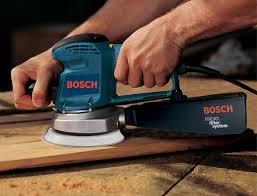Wood preparation, prior to staining, should always be thorough so as to achieve a top quality finish. There are a number of factors that will determine the final outcome, including the type and quality of the wood and the curing method, which ensures optimum water content.
After cutting and planing, the next important task is to ensure that all surfaces of the wood are properly prepared ready for assembly and the application of the wood finish, whether this is a wood stain, clear lacquer, or a block colour paint..
After cutting and planing, the next important task is to ensure that all surfaces of the wood are properly prepared ready for assembly and the application of the wood finish, whether this is a wood stain, clear lacquer, or a block colour paint..
Polmac (UK) Ltd Craftsman Using A Mechanical Sanding Wheel
Sandpaper or glass paper, as it is sometimes called, comprises sheets of paper or cloth with an abrasive material glued to one surface. However, neither sand nor glass is now used in the manufacture of sandpaper, as they have been replaced by safer and more durable, modern abrasives.
Sanding a rough surface smooth for a wood finish may seem simple enough but different woodworking experts have different opinions about how best to achieve this, in the most efficient way.
All surfaces of the wood should be sanded evenly, working through the sanding grits from course to fine. Course sanding paper is used to eliminate tool marks and flatten large surfaces.
Then each successive sandpaper grade, from medium to fine can be used to eliminate the scratches left by the previous sanding.
On flat surfaces, sandpaper should be backed by a sanding block. These are usually made from cork, or you can use a ready made, disposable sanding block made with the sandpaper glued to rigid foam, if you prefer.
On flat surfaces, sandpaper should be backed by a sanding block. These are usually made from cork, or you can use a ready made, disposable sanding block made with the sandpaper glued to rigid foam, if you prefer.
During sanding, it's important to sight along the wood surface to ensure an even sheen with no scratches left from the previous grit. You can then move on to the next grit.
When sanding manually, you should use light even pressure, because too much pressure will mark the wood unnecessarily. The weight of your hand, combined with even strokes should be perfectly adequate.
If you decide to use a power sander, a random-orbit sander, rather than a belt or vibrating sander is best, as they rarely leave noticeable scratch patterns.
When sanding manually, you should use light even pressure, because too much pressure will mark the wood unnecessarily. The weight of your hand, combined with even strokes should be perfectly adequate.
If you decide to use a power sander, a random-orbit sander, rather than a belt or vibrating sander is best, as they rarely leave noticeable scratch patterns.
Random Orbit Sander
When using a power sander, the weight of the sander will provide sufficient pressure to give you the smooth, even finish you're looking for!
Be sure to take the above wood preparation advice seriously, if you want a top quality wood finish!



No comments:
Post a Comment